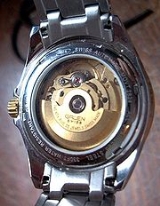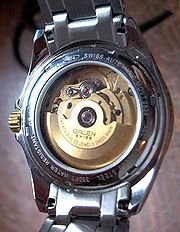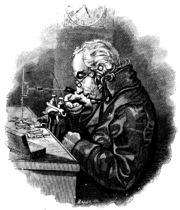
Automatic watch
Encyclopedia

Mechanical watch
A mechanical watch is a watch that uses a mechanical mechanism to measure the passage of time, as opposed to modern quartz watches which function electronically. It is driven by a spring which must be wound periodically...
watch
Watch
A watch is a small timepiece, typically worn either on the wrist or attached on a chain and carried in a pocket, with wristwatches being the most common type of watch used today. They evolved in the 17th century from spring powered clocks, which appeared in the 15th century. The first watches were...
, whose mainspring
Mainspring
A mainspring is a spiral torsion spring of metal ribbon that is the power source in mechanical watches and some clocks. Winding the timepiece, by turning a knob or key, stores energy in the mainspring by twisting the spiral tighter. The force of the mainspring then turns the clock's wheels as it...
is wound automatically by the natural motion of the wearer's arm, providing energy to run the watch, to make it unnecessary to manually wind the watch. A watch which is not self-winding is called a manual watch. Most mechanical watches sold today are self-winding.
How it works
A mechanical watchMechanical watch
A mechanical watch is a watch that uses a mechanical mechanism to measure the passage of time, as opposed to modern quartz watches which function electronically. It is driven by a spring which must be wound periodically...
is powered by an internal spiral spring
Spring (device)
A spring is an elastic object used to store mechanical energy. Springs are usually made out of spring steel. Small springs can be wound from pre-hardened stock, while larger ones are made from annealed steel and hardened after fabrication...
called a mainspring
Mainspring
A mainspring is a spiral torsion spring of metal ribbon that is the power source in mechanical watches and some clocks. Winding the timepiece, by turning a knob or key, stores energy in the mainspring by twisting the spiral tighter. The force of the mainspring then turns the clock's wheels as it...
which turns the gears that move the hands. The spring loses energy as the watch runs, so in a manual watch movement the spring must be daily "wound" by the owner turning a small knob on the case to provide energy to run the watch, otherwise the watch runs down and stops.
A self-winding watch movement is similar to a manual movement with the addition of a mechanism powered by an eccentric weight which winds the mainspring. The watch contains a semicircular 'rotor', an eccentric weight that turns on a pivot, within the watch case. The normal movements of the user's arm and wrist cause the rotor to pivot back-and-forth on its staff, which is attached to a ratchet
Ratchet (device)
A ratchet is a device that allows continuous linear or rotary motion in only one direction while preventing motion in the opposite direction. Because most socket wrenches today use ratcheting handles, the term "ratchet" alone is often used to refer to a ratcheting wrench, and the terms "ratchet"...
ed winding mechanism. The motion of the wearer's arm is thereby translated into the circular motion of the rotor that, through a series of reverser and reducing gears, eventually winds the mainspring. Modern self-winding mechanisms have two ratchets and wind the mainspring during both clockwise and counterclockwise rotor motions.
The fully wound mainspring in a typical watch can store enough energy reserve for roughly two days, allowing automatics to keep running through the night while off the wrist. In many cases automatic watches can also be wound manually by turning the crown, so the watch can be kept running when not worn, and in case the wearer's wrist motions are not sufficient to keep it wound automatically.
Preventing overwinding
A problem that had to be solved with self-winding mechanisms is that they continued working even after the mainspring was fully wound up, putting excessive tension on the mainspring. This could break the mainspring, but even when it didn't, it caused a problem called 'knocking' or 'banking'. The excessive drive force applied to the watch movement gear train made the balance wheelBalance wheel
The balance wheel is the timekeeping device used in mechanical watches and some clocks, analogous to the pendulum in a pendulum clock. It is a weighted wheel that rotates back and forth, being returned toward its center position by a spiral spring, the balance spring or hairspring...
rotate with too much amplitude
Amplitude
Amplitude is the magnitude of change in the oscillating variable with each oscillation within an oscillating system. For example, sound waves in air are oscillations in atmospheric pressure and their amplitudes are proportional to the change in pressure during one oscillation...
, that is too far in each direction, causing the impulse pin to hit the back of the pallet fork
Pallet fork
The pallet fork or pallet lever is an integral component of the lever escapement of a typical mechanical watch. Its purpose is to release the escape wheel one tooth at a time, at each swing of the balance wheel, and also give the balance wheel small pushes to keep it going.The lever is shaped like...
horns. This made the watch run fast, and could break the impulse pin. To prevent this, a slipping clutch device is used on the mainspring so it cannot be overwound.
The slipping spring or 'bridle'
The 'slipping mainspring' device was patented by Adrien PhilippeAdrien Philippe
Jean Adrien Philippe was French horologist and cofounder of watchmaker Patek Philippe & Co. of Geneva, Switzerland.In 1842 Adrien Philippe invented a mechanism for watches which allowed them to be wound and set by means of crown rather than a key. His patented invention earned him a Gold Medal at...
, founder of Patek Philippe, on June 16, 1863, long before self-winding watches. It was invented to allow simultaneous winding of two mainspring barrels. In an ordinary watch mainspring barrel
Barrel (horology)
Used in mechanical watches and clocks, a barrel is a cylindrical metal box closed by a cover, with a ring of gear teeth around it, containing a spiral spring called the mainspring, which provides power to run the timepiece. The barrel turns on an arbor . The spring is hooked to the barrel at its...
, the outer end of the spiral mainspring is attached to the inside of the barrel. In the slipping barrel, the mainspring is attached to a circular steel expansion spring, often called the 'bridle', which presses against the inside wall of the barrel, which has serrations or notches to hold it.
As long as the mainspring is less than fully wound, the bridle holds the mainspring by friction to the barrel wall, allowing the mainspring to be wound. When the mainspring reaches full wind, its force is stronger than the bridle spring, and further winding pulls the bridle loose from the notches and it simply slides along the wall, preventing the mainspring from being wound further. The bridle must grip the barrel wall with just the right force to allow the mainspring to wind fully but not overwind. If it grips too loosely, the mainspring will begin to slip before it is fully wound, a defect known as 'mainspring creep' which results in a shortened reserve power time.
A further advantage of this device is that the mainspring can't be broken by overzealous manual winding. This feature is usually advertised by watch companies by putting the words "unbreakable mainspring" on the watch's face or back.
Automatic quartz or kinetic movement
More recently, electronic automatic quartzAutomatic quartz
Automatic quartz is a collective term describing watch movements that combine a self-winding rotor mechanism to generate electricity with a piezoelectric quartz crystal as its timing element. Such movements aim to provide the advantages of quartz without the environmental impact of batteries...
watches that are powered by arm movement have been developed. A weighted rotor turns a tiny electrical generator
Electrical generator
In electricity generation, an electric generator is a device that converts mechanical energy to electrical energy. A generator forces electric charge to flow through an external electrical circuit. It is analogous to a water pump, which causes water to flow...
, charging an accumulator
Accumulator
Accumulator may refer to:* Accumulator , in a CPU, a processor register for storing intermediate results* Accumulator , an apparatus for storing energy or power...
, such as a rechargeable battery
Rechargeable battery
A rechargeable battery or storage battery is a group of one or more electrochemical cells. They are known as secondary cells because their electrochemical reactions are electrically reversible. Rechargeable batteries come in many different shapes and sizes, ranging anything from a button cell to...
or capacitor
Capacitor
A capacitor is a passive two-terminal electrical component used to store energy in an electric field. The forms of practical capacitors vary widely, but all contain at least two electrical conductors separated by a dielectric ; for example, one common construction consists of metal foils separated...
, which powers the quartz
Crystal oscillator
A crystal oscillator is an electronic oscillator circuit that uses the mechanical resonance of a vibrating crystal of piezoelectric material to create an electrical signal with a very precise frequency...
movement. This automatic quartz
Automatic quartz
Automatic quartz is a collective term describing watch movements that combine a self-winding rotor mechanism to generate electricity with a piezoelectric quartz crystal as its timing element. Such movements aim to provide the advantages of quartz without the environmental impact of batteries...
arrangement provides the accuracy of quartz without the need to replace the battery or capacitor until it reaches the end of its life, which may be decades. This is also called Kinetic movement, which was first introduced by Seiko
Seiko
, more commonly known simply as Seiko , is a Japanese watch company.-History and ongoing developments:The company was founded in 1881, when Kintarō Hattori opened a watch and jewelry shop called in the Ginza area of Tokyo, Japan. Eleven years later, in 1892, he began to produce clocks under the...
.
The watch winder
For people who do not wear their automatic watch every day, watch winders are available to store automatic watches and keep them wound. This is particularly advantageous if the watch has complicationsComplication (horology)
In horology , complication refers to any feature in a timepiece beyond the simple display of hours, minutes, and seconds.A timepiece indicating only hours, minutes, and seconds is otherwise known as a simple movement...
, like perpetual calendars or moon phases. A watch winder is a device that can hold one or more watches and moves them in circular patterns to approximate the human motion that otherwise keeps the self-winding mechanism working. Older mechanical watches should be kept wound and running as much as possible to prevent their lubricants from congealing over time, which diminishes accuracy. Modern mechanical watches generally use synthetic oil; whether or not synthetic oils congeal is a point of contention among watch experts. A full service (which involves disassembly, cleaning and re-lubrication) should be performed at least every five years to keep the movement as accurate as possible.
Perrelet: 1770

Abraham-Louis Perrelet
Abraham-Louis Perrelet, , born in Neuchâtel in Switzerland was a Swiss horologist.Perrelet invented a self-winding mechanism in 1770 for pocket watches...
invented a self-winding mechanism in 1770 for pocket watch
Pocket watch
A pocket watch is a watch that is made to be carried in a pocket, as opposed to a wristwatch, which is strapped to the wrist. They were the most common type of watch from their development in the 16th century until wristwatches became popular after World War I during which a transitional design,...
es. It worked on the same principle as a modern pedometer
Pedometer
A pedometer is a device, usually portable and electronic or electromechanical, that counts each step a person takes by detecting the motion of the person's hips...
, and was designed to wind as the owner walked, using an oscillating weight inside the large watch that moved up and down. The Geneva Society of Arts reported in 1776 that fifteen minutes walking was necessary to wind the watch sufficiently for eight days, and the following year reported that it was selling well.
Breguet: 1780
Perrelet sold some of his watches to a contemporary watch making luminary, Abraham-Louis Breguet around 1780 who improved upon the mechanism in his own version of the design, calling his watches "perpetuelles" the French word for perpetual. They did not work reliably and Breguet stopped producing them around 1800.'Bumper' wristwatches: 1923
Self winding mechanisms were more successful in wristwatches because a person's arm moves much more during daily activities than his torso, where a pocketwatch is kept; the rotor could operate every time the owner moved his or her arm. The first self-winding wristwatch did not appear until after World War IWorld War I
World War I , which was predominantly called the World War or the Great War from its occurrence until 1939, and the First World War or World War I thereafter, was a major war centred in Europe that began on 28 July 1914 and lasted until 11 November 1918...
, when wristwatches became popular. It was invented by a watch repairer from Bolton named John Harwood in 1923, who took out a UK patent with his financial backer, Harry Cutts, on 7 July 1923, and a corresponding Swiss patent on 16 October 1923. The Harwood system used a pivoting weight which swung as the wearer moved, and which in turn wound the mainspring. The ratchet mechanism only wound the mainspring when moving in one direction. The weight didn't rotate a full 360°; spring bumpers limited its swing to about 180°, to encourage a back and forth motion. This early type of self-winding mechanism is now referred to as a 'hammer' or 'bumper'.
When fully wound, Harwood's watch would run for 12 hours autonomously. It did not have a conventional stem winder, so the hands were moved manually by rotating a bezel around the face of the watch. The watches were first produced with the help of Swiss watch manufacturer Fortis
Fortis Uhren AG
Fortis is a watchmaker founded and based in Grenchen Switzerland that was established by Walter Vogt in 1912.- History :12 years after its establishment, Walter Vogt set up production with John Harwood, the inventor of the automatic wristwatch. In 1926, Fortis released the first self-winding...
and went on sale in 1928. 30,000 were made before the Harwood Self-Winding Watch Company collapsed in 1931 as a result of the Great Depression
Great Depression
The Great Depression was a severe worldwide economic depression in the decade preceding World War II. The timing of the Great Depression varied across nations, but in most countries it started in about 1929 and lasted until the late 1930s or early 1940s...
. 'Bumper' watches were the first commercially successful automatic watches; they were made by several high grade watch manufacturers during the 1930s and 1940s.
Rolex
The RolexRolex
Rolex SA is a Swiss watchmaking manufacturer of high-quality, luxury wristwatches. Rolex watches are popularly regarded as status symbols and BusinessWeek magazine ranks Rolex No.71 on its 2007 annual list of the 100 most valuable global brands...
Watch Company improved Harwood's design in 1930 and used it as the basis for the Rolex Oyster Perpetual, in which the centrally mounted semi-circular weight could rotate through a full 360° rather than the 300° of the 'bumper' winder. Rolex's version also increased the amount of energy stored in the mainspring, allowing it to run autonomously for up to 35 hours.
By the 1960s, automatic winding became standard in quality mechanical watches. Because the weighted rotor needed in an automatic watch takes up a lot of room in the case, increasing the thickness of the watch, some high end watch companies, such as Patek Philippe, continue to design manually wound watches, which can achieve a case thickness as low as 1.77 millimeters.
External links
- A visual guide to the gears that make bi-directional winding possible
- A detailed evaluation of the mechanics of the Seiko 7S26 automatic watch movement Photos of early automatic movements on German watch vendor site, including the Harwood
- Video of the making of an automatic watch from orient watch company
- Video of an automatic watch mechanism in a transparent case
- Video of a watch on a watch winder

